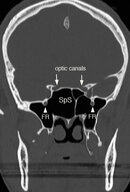If y'all will indulge me for a minute, I'd like to summarize what we have so far, along with the short version of some consultations:
A healthy 50 year old male with no significant past medical history makes a dive, breathing gas unknown but presumed to be air or nitrox. He reports no difficulty equalizing his ears or sinuses, and equalizes via the Toynbee (pinch and swallow) maneuver vs. the Valsalva maneuver. On descent he noticed decreased vision in his right eye but assumed it to be related to mask fogging and continued his descent. At 22 meters (72 FSW) he reported complete loss of vision in the right eye. He continued his descent, and at a depth of 26 meters (85 FSW) he reported a complete loss of vision.
He immediately made a controlled ascent with the assistance of the dive guide, and reported an improvement of vision at a depth of 7-8 meters (23-26 FSW) with complete resolution of symptoms upon reaching the surface. At the surface, it was noted that his eyes were red and the area around his eyes was swollen. There was a small amount of blood around the seal of the mask. The divemaster on the boat diagnosed mask squeeze, but the diver and his buddy are not sure, as they have seen severe mask squeeze and that diver's appearance was different. Exact description of the appearance of his eyes is lacking, and there are no photographs.
Complete exam by an ophthalmologist an unknown time after the dive reveals no abnormalities. Intraocular pressures are normal, and a fundoscopic exam of the retinas is unremarkable.
DocV and Cutlass, does this sound pretty accurate to y'all?
What we've already pretty much ruled out:
1. O2 toxicity.
2. Open angle glaucoma, narrow angle glaucoma, normal pressure glaucoma, and bad glaucomb-over.
3. Acute retinal detachment.
So far, I've spoken with two of our attendings, Dr. Jake Freiberger and Dr. Richard Moon; chief DAN medic Dan Nord; and CAPT Frank Butler, USN (RET) CAPT Butler is a well-known Navy diving medical officer with a specialty in ophthalmology. Here are the opinions:
Before hearing the results of the ophthalmology visit, Dr. Freiberger believed this was a mask squeeze, worrisome for possible glaucoma aggravation.
Dr. Moon believes it's a mask squeeze complicated by sinus squeeze and retinal ischemia, but worrisome for non-diving-related CNS causes like embolic shower to the optic center.
Dan Nord said it sounds like a mask squeeze/sinus squeeze.
CAPT Butler believes the blood in the mask is key, and that this is barotrauma of the sphenoid sinus, probably complicated by mask squeeze. His rationale is that the sphenoid sinus is immediately adjacent to the optic chiasm and there are other case reports of peripheral neuritis related to barotrauma, though none like this. He sent me an image, which is attached. The sphenoid sinus is labeled SpS, and the optic canals are noted.
None of the practitioners I consulted with had heard of a similar case.
Recommendations:
Dr. Freiberger: follow up with an ophthalmologist; already completed.
Dr. Moon: Follow up with a neurologist to rule out non-diving-related neurological causes.
CAPT Butler: See if the ophthalmologist or another practitioner will order a CT scan of the sinuses. Depending on how far out from the injury the CT is performed, it may show residual blood/fluid in the sphenoid sinus and would probably be diagnostic in that case.
Questions that remain: Aviayu, what day did you make the dive, and how long after the dive did you see the ophthalmologist? Can you verify again that you have had no acute or chronic sinus problems, perhaps allergies, a cold, or infection? Are you a smoker? Finally, if it's been a short enough time since the dive (less than a week or so), would it be possible for you to get a CT scan of your sinuses?
This is a fascinating case. Aviayu, I think we'd all like to see this through to a conclusion and I know all the practitioners here will help in any way possible.




